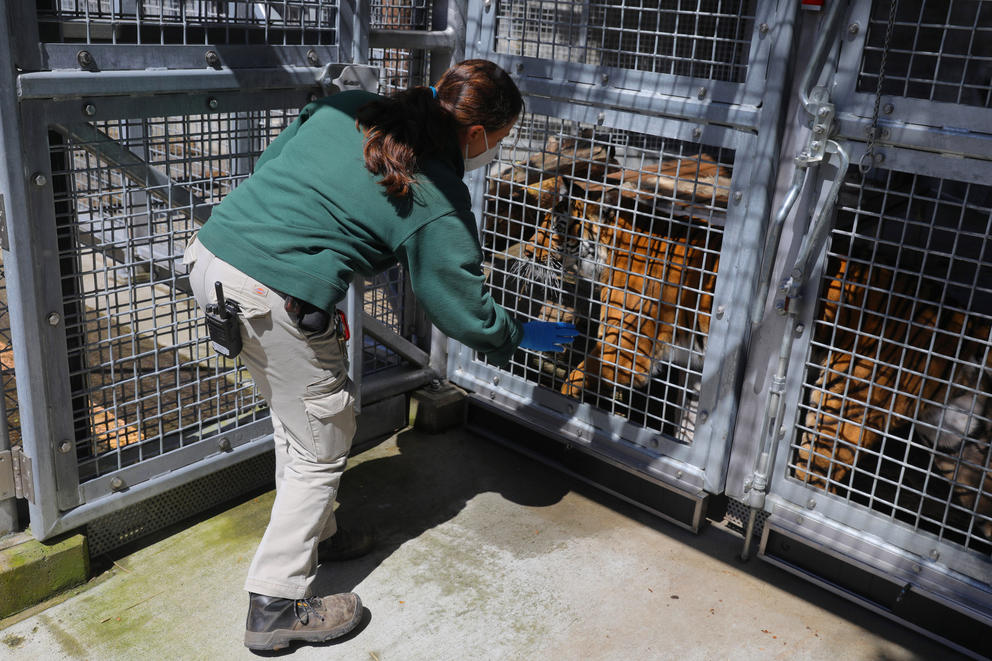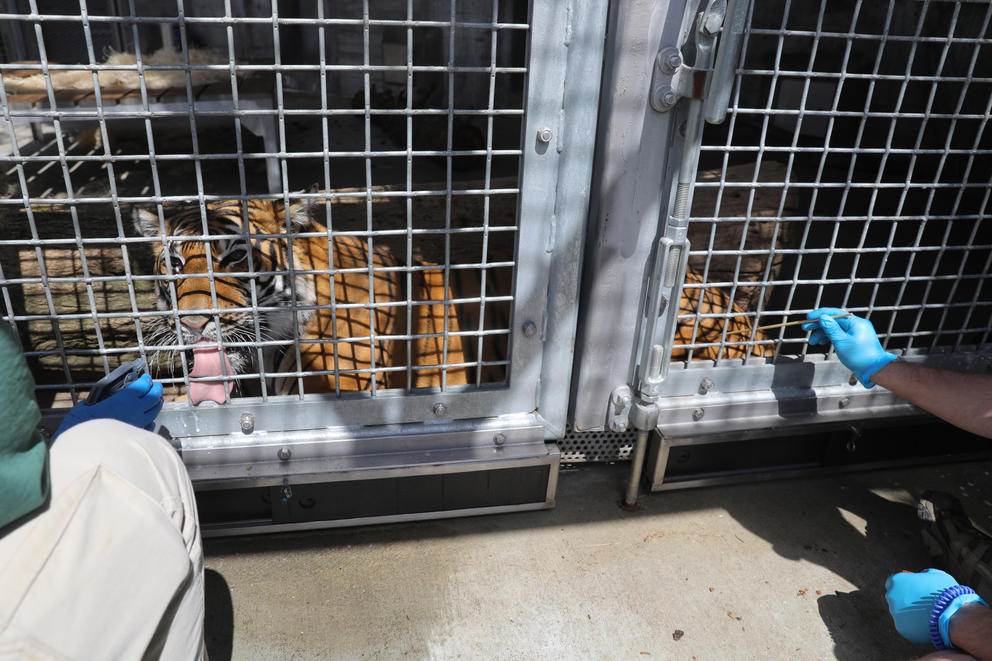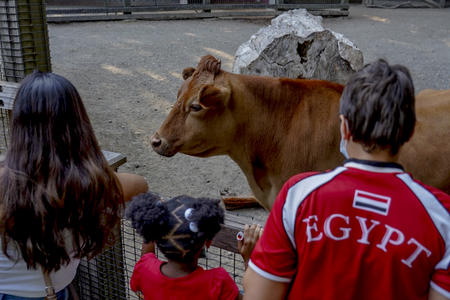Azul and Anne, lead animal keeper at the zoo, are on opposite sides of a metal mesh outdoor enclosure, but they’ll be interacting through the grates momentarily as part of Azul’s regular vaccination training.
Just like people, tigers and other mammals are vulnerable to coronaviruses like the one responsible for the current pandemic, which means dozens of Woodland Park’s animals are at risk. Zoo employees have been wearing personal protective equipment to avoid infecting the animals.
Azul, who moved to Woodland Park Zoo in September 2020, was one of the first animals in the United States to get COVID — while living at the Bronx Zoo in New York. Like many who contracted the virus, Azul also experienced a loss of appetite, lethargy and coughing for a few days in April 2020.
American drug company Zoetis began donating its experimental COVID-19 animal vaccine to zoos in June 2021. Woodland Park Zoo received 100 donated doses — enough to vaccinate 50 animals twice — in late February, after state and federal permissions allowed distribution in Washington state. As of May 4, the zoo has since been able to fully vaccinate 48 animals.
Zookeepers and veterinary technicians administer the vaccine by hand while animals are awake—a new experience for many of Woodland Park’s mammals, who often undergo medical procedures while under anesthesia or while restrained. This created urgency for the zoo’s vet staff, and an opportunity to improve animal welfare: Woodland Park employees believe that giving animals choice and agency in their care improves their health and quality of life.
Azul, a Malayan tiger at Woodland Park Zoo, licks her enclosure while lead animal keeper Christine Anne sprays evaporated milk at her as part of a vaccine injection training on April 26, 2022. (Hannah Weinberger/Crosscut.)
Woodland Park keepers began leading animals like Azul through daily training last September to receive the vaccine voluntarily, as well as training to draw blood for antibody monitoring and other routine testing. “The animals have been super-cooperative. ... It’s gone much much more smoothly than I was afraid it might,” says Dr. Tim Storms, a veterinarian and the zoo’s director of animal health, who noted the zoo hasn’t seen animals experiencing any adverse reactions post-vaccination.
Whether animals can truly volunteer for vaccination is disputable. But as many of us debate personal health decisions during the pandemic, Woodland Park employees hold that giving animals more say over their participation in their medical experiences improves their physical and mental health, and ultimately helps the zoo better protect them.
Training an animal to receive a vaccine
To the uninitiated, it might look like the first step to vaccinating a tiger is raiding a restaurant supply store.
The goal of injection training is to help animals tolerate an uncomfortable jab to their hip. Keepers do that by introducing animals like Azul to gradually more uncomfortable jabs using tools available to them. Some animals progress faster than others, especially if they’ve already undergone injection training for other shots, as some of the big cats have.
The progression for big cats is as follows: poking with the blunt end of a target stick (which looks like a large plastic cotton swab); then with both ends of a chopstick and later a kebab skewer; and, finally, a paper clip taped to a stick. They don’t move to the next tool in the progression until an animal is completely comfortable with—that is, expressing little to no reaction to—the current tool. Other animals follow a similar protocol.
The key to getting animals to endure all these pokes, Anne says, is giving them a reason to stick around despite the injection. Although Azul likely doesn’t enjoy being jabbed, she is willing to participate in training because she knows Anne will spritz her face with a solution of evaporated milk and water every few seconds. Keepers use clicker training to indicate to animals that they’re doing the right thing.
Importantly, the zoo doesn’t retaliate against animals that don’t participate, which helps build safety and trust, says animal welfare scientist Dr. Bonnie Baird.
When Anne approaches Azul with the target stick and the spray bottle, Azul eagerly runs up to the gate. “Usually when we come back here and we open up those doors, they know that it's go-time,” she says, rewarding Azul with a milk facial. “Good girl!”
It can take time for animals to learn these behaviors, in part because, Anne says frankly, the practice shots can hurt. Bumi, the 12-year old male tiger, had been injection-trained before the pandemic. But after he started training again, he would wander off, which let Anne know “he’s anticipating something horrible happening.” He eventually became more comfortable with the training sessions after Anne started rewarding him with meat.
There’s no real way for trainers to differentiate whether an animal feels distress, discomfort or pain, Anne says, so they just assume it hurts, and they stop the training to err on the side of caution.
Training a tiger is risky even with the gate separating keeper and animal. To keep everyone safe, Anne partners up with her colleague Matt Cline. Anne focuses on keeping Azul’s attention. Sitting at her “business end,” Anne asks Azul to nose-touch the target stick in exchange for milk. While Azul is occupied, Cline sits near Azul’s hip and typically administers three quick practice pokes on each side.
“I’m a Type 1 diabetic, so I do my own [shots] everyday,” Cline says.
Anne watches Azul’s face to make sure she’s focused on the target stick and snacks, not what’s going on toward her hip. Cline examines her posture, and how tense she is. If her behavior changes, everyone pauses.
Next, they practice blood draws. Tigers have strong veins in their tails, which Cline can access by opening a small sliding door at the bottom of the enclosure gate. While Azul is laser-focused on Anne, Cline can grasp Azul’s tail with a tool usually reserved for handling poisonous snakes.
It takes a few tries, but Cline eventually guides Azul’s tail onto his side of the gate, does the fake blood draw and then they repeat the training on the tiger’s other side. In total, the training takes only a few minutes, and about 6 ounces of milk. Azul sticks around briefly, hoping for another treat.
“We can’t make her sit there and be touched and manipulated. If she wants to get up and go away, she’ll get up and go away,” Anne says. “And that’s perfectly fine.”
Why go through all of this trouble?
It took months of daily close-contact work to train animals for voluntary injections. Despite the risk of exposing the animals to COVID, the time invested felt important to zoo staff.
Over the past few years, Woodland Park Zoo has been a leading organization in the zoo community as it explores the value of giving animals more agency over their own lives.
Anytime keepers can give animals opportunities to safely make choices, it’s better for everyone because animals are more relaxed and easier to work with, Anne says. Involving animals in their medical care with the person they trust most, their keeper, can also help get their buy-in with fewer risks.
During a round of voluntary injection training, animal keeper Matt Cline holds female Malayan tiger Azul’s tail and pokes it with a kebab skewer to simulate a blood draw. The tigers trained for this procedure so that when the need for a real vaccination and blood draw occurred they would be comfortable and tolerate sitting for the vaccination without needing to be sedated or restrained. Both Woodland Park Malayan tigers were vaccinated against the novel coronavirus in March 2022, and were ready to receive vaccines after three months of daily training. (Genna Martin/Crosscut)
The traditional way of giving animals medical care was basically subjugation — by netting and holding them down, or darting them if they’re large. “It’s like when you have to take your house cat to the vet and there’s a struggle to get them into their crate and they’re screaming the whole way,” says Rachel Salant, Woodland Park’s curator of behavioral husbandry and ambassador animals. The animals present danger to people and themselves when they flail in attempts to leave.
The fact that zoo professionals are able to hand-vaccinate and draw blood with awake, tolerant animals is already paying off medically, giving the zoo more continuous health data and allowing veterinarians to diagnose health problems at an earlier stage, Storms says. That includes Bumi, the male tiger, who has early stage kidney issues.
Storms says that many animals will continue to have periodic exams under anesthesia or restraint, but the more tools in a veterinarian’s toolbelt, the better.
And not every vulnerable animal has the option of getting a vaccine against every dangerous virus. The zoo is making contingency plans for future outbreaks of the highly pathogenic avian influenza virus. Storms says there isn’t a vaccine against it available yet, and that it’s unlikely it will be available for zoo birds.
Zoo professionals have been investigating what they can do to help animals thrive in a zoo setting, Salant says. In addition to food, water and shelter, it turns out, control or perception of control over one’s outcomes and environment is a basic need, just as it is for people.
“No one has 100% choice in anything they do — you don’t, I don’t, animals in the wild don’t. But even increasing your perception of choice increases your well-being,” Salant says.
This training requires a mindset shift for keepers, says animal welfare scientist Dr. Bonnie Baird. “How we care for animals [is going] from doing things to them for their own good to doing things with them for our collective good,” she says.
The limitations of choice
Woodland Park Zoo press releases describe the vaccination as voluntary. But the vaccine expires quickly after being opened, and the zoo didn’t have unlimited time to train each animal. Given those constraints, all of the animals needing vaccinations ultimately received them regardless of whether they progressed far enough in injection training.
Salant says two maned wolves and a jaguar needed more time to learn how to do voluntary injections than the zoo was able to give them and Storms, the veterinarian, ended up giving them remote injections. Most of the animals received hand injections voluntarily, but a few were given “opportunistic” injections in close quarters. “It wasn’t completely voluntary, but it also wasn’t that coercive,” Storms, the veterinarian, says.
Determining whether animals can volunteer or give consent for anything, especially in zoos, can be very difficult, says Dr. Karen Emmerman, an independent scholar and part-time faculty member at the University of Washington’s philosophy department.
Consent implies understanding the thing being done to you and agreeing to its long-term risks, says Emmerman, who spends a lot of time thinking about animal captivity in sanctuary, as well as zoo settings, and has written moral arguments against zoos. It’s possible some animals have the ability to give consent, but she says it’s deeply questionable whether humans would actually pick up on it.
“Obviously we can't give them the information about the risks and benefits of vaccination that is an essential part of informed consent to medical treatment,” renowned author and ethicist Peter Singer, writes via email.
Doing something voluntarily may require a lower bar, because you can volunteer for something you don’t fully understand. But doing that in a zoo context means first accepting that animals aren’t there by choice in the first place, and don’t have control over their daily activities and reproductive lives, Emmerman says.
Zoo employees ultimately have to decide whether animals appear to be volunteering for treatment, Baird says. Often, keepers interpret receiving an animal’s consent when said animal stays in a situation like a training session.
“I mean, obviously, they can’t express their opinion about the matter — whether or not they’re concerned about a virus and would like to be protected, or don’t feel like the vaccine is for them,” Storms says, “so it’s up to us as the veterinarians and as the zoo caretakers to do what's reasonably best for them to protect their health.”
Emmerman, who supports vaccination for humans, says that recognizing that responsibility is necessary in a zoo setting. “When you're already in nonideal circumstances — if you're already in ethically problematic terrain — then you're forced to make decisions that are the best decisions you can make,” she says.
At the end of the day, it might be better to describe what the zoo is doing as training desensitization to something uncomfortable, rather than asking animals to volunteer or do with informed consent. Woodland Park’s employees realize its animals are allowing a process to happen, more than volunteering for it.
Storms recognizes that the context in which this training happens include a power imbalance. “Even the decision to train an animal [for hand injections] … is a decision by us.”
During a round of voluntary injection training, animal keeper Matt Cline, right, pokes female Malayan tiger Azul’s haunch with a kebab skewer to simulate a blood draw, as lead keeper Christine Anne, left, rewards her with sprays from a bottle of evaporated milk solution. The tigers trained for this procedure daily for three months, so that when the need for a real vaccination or blood draw occurred they would be comfortable and tolerate the vaccination without needing to be sedated or restrained. (Genna Martin/Crosscut)
Building emotional resilience
Regardless of whether animals would get vaccinated by choice, zoo keepers hope introducing animals to uncomfortable things and making them less scary helps animals build emotional resilience, which they believe is also important for their welfare.
This process of building resilience is something all of us can use to better work with the animals — and people — in our lives.
“How I work with pets at home, how I work with my husband, how I work with people’s children — behavior is behavior, regardless of species. And everything about behavior is about consequences,” says Salant, the curator of behavioral husbandry and ambassador animals.
Just like Azul at Woodland Park Zoo, even veterinarian-averse house cats can be trained out of avoidance behavior. The key is understanding their motivation, Salant says. If a cat only ever sees its crate on days it goes to the vet, it will associate it with negative feelings. But if its crate is treated as a place of comfort, maybe even where it gets treats, it will be easier to get it to walk into the crate on vet days.
The way we signal our feelings about situations can influence how our pets feel about them, Baird says. If you’re going to the vet, then you can’t let them know you’re a little nervous for them. “You’ve gotta be the animal’s hype man,” Baird says.










